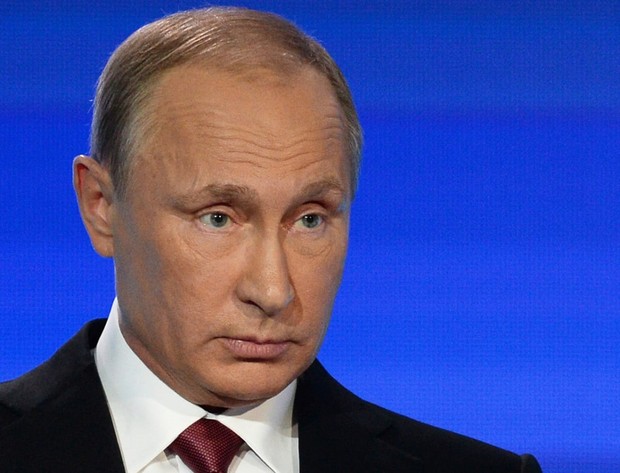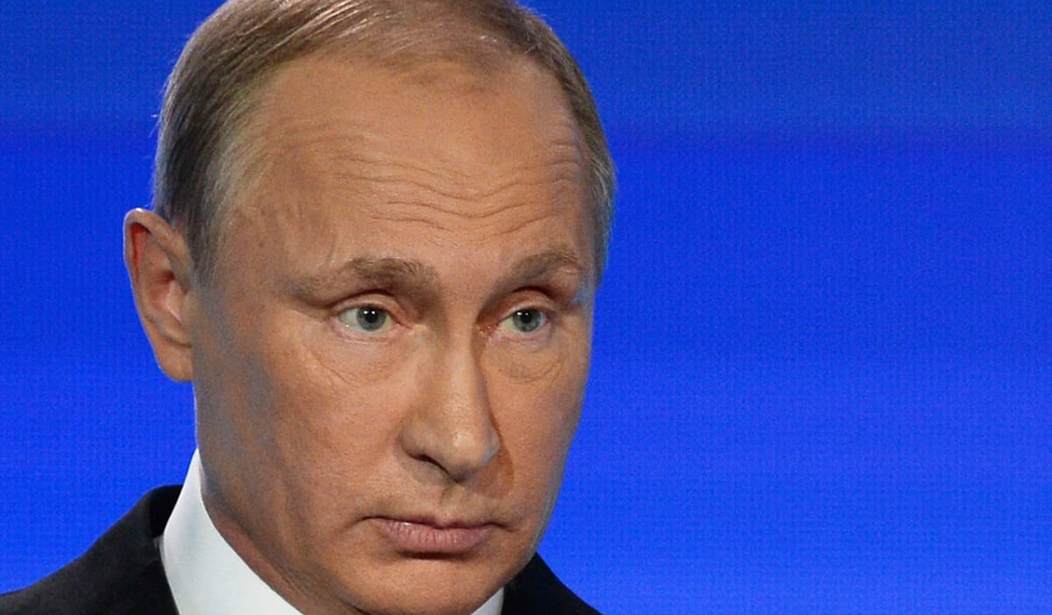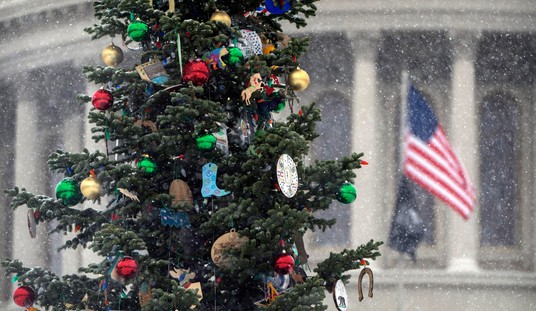
Russian President Vladimir Putin speaks at a meeting of the Valdai International Discussion Club in Sochi, Russia, Thursday, Oct. 27, 2016. President Vladimir Putin says the claims of Russia’s interference in the U.S. presidential election are designed to distract public attention from real issues.(Maxim Blinov/Sputnik, Kremlin Pool Photo via AP)
In just the past couple of weeks, there have been headlines about large-scale Russian military exercises, of RAF fighters being scrambled to intercept Russian bombers nearing UK airspace, of Russian surface combatants making their way through the English Channel, and worries about Russia targeting undersea communications cables. To take these at face value, one would have to assume Russia is undergoing a military resurgence. The truth is quite a bit different. Russia is looking national bankruptcy in the face and is ill-prepared to do so.
Back in 2004, Russia established what was called the “Stabilization Fund of the Russian Federation.” The idea was pretty simple. Most of Russia’s wealth comes from oil. The fund received any excess on oil sales above the $27 per barrel mark. The idea was that this fund would allow smooth functioning of the national budget in the case of a market downturn or disruption in production. All went along well and by January 2008 the fund was home to $157 billion. What happens next is predictable in a kleptocratic kakistocracy like Russia. There was a large piggy bank there, just ripe for the pilfering, and a lot of hands that wanted to pilfer it.
In 2008, the fund was split into two funds. There was a reserve fund that was supposed to be invested in safe investments abroad and a national well-being fund that is invested in “riskier, high-return” investments to balance Russia’s budget. Now the reserve fund, which started out with about $125 billion is being zeroed out.
Russia’s Reserve Fund was finally exhausted in December 2017 and will formally cease to exist on February 1, 2018, the Finance Ministry reported on Wednesday. Composed of tax revenue collected from the oil and gas industry, the Russian government created the Reserve Fund in 2008, setting new allocation amounts annually. Any oil and gas revenues that weren’t deposited into the Reserve Fund were transferred to Russia’s National Welfare Fund.
- The size of the Reserve Fund peaked early on in September 2008, when its accounts reached $142.6 billion. By the end of 2014, the fund had fallen to $88.9 billion. Beginning in 2015, Moscow actively started spending from the Reserve Fund to plug federal budget deficits.
- Russian finance officials originally expected the Reserve Fund to empty out in early 2017, but it lasted an extra year, thanks to the price of oil remaining above $50 a barrel.
- With the collapse of the Reserve Fund, the Russian government plans to use the National Welfare Fund to cover budget deficits.On January 1, 2018, there were 3.75 trillion rubles ($65.9 billion) in welfare fund’s accounts.
Russia has exhausted its rainy-day Reserve Fund used to plug budget gaps. pic.twitter.com/y16MQRbrWe
— Radio Free Europe/Radio Liberty (@RFERL) January 11, 2018
In December 🇷🇺#Russia used all $17.1bn in Reserve Fund to cover budget deficit, as planned. Going forward there will be only one fund, National Welfare Fund. Its size $66.2bn at end-2017. pic.twitter.com/duf6f9EVsA
— Iikka Korhonen (@IikkaKorhonen) January 10, 2018
The burn rate here is interesting. It lost $53.7 billion from 2008 to 2014. From 2014 through 2017 they burned through $88.9 billion. The reserve fund has $65.9 billion, at the current burn rate that is just over two years worth of expenditures assuming the dips into the well-being fund were straight-line and not increasing year by year. It is much more likely that this fund will be exhausted in just over a year and then Russia will have to engage in deficit spending on a massive scale. But with what? In the past few years, Russia’s bonds have been in and out of junk status. Right now it is at the low end of “investment grade” with ratings on par with South Africa, Cyprus, and Namibia. Low oil prices and a budget deficit and the usual lack of transparency are not going to improve that rating.
How does this connect with the military exercises? Well, they are expensive. During the Cold War major Warsaw Pact exercises, like Brotherhood in Arms and Red Star, resulted in extensive damage to Soviet and Warsaw Pact equipment and prolonged repair times. The sorties by the Russian navy into the Atlantic are not cheap. The Russian adventures in Syria and Ukraine are also drains on the economy. An OPTEMPO that allows you to send bombers towards the UK, Guam, etc., has costs. In short, Russia’s military actions are incompatible with its economy. It can do a certain number of things to draw attention and to try to burnish its national narrative of relevance, but these activities should be viewed for what they are. They are theater, pure and simple.
Meanwhile Russia's strategic reserve fund has bottomed out, btw $900 mln – $1 bln in foreign investment exposure to the Russian economy left in 2017, GDP per capital fell by $5.5K from 2012-2018, & ruble tied to oil futures – but yeah, Syria. https://t.co/F0wpNKeQBl
— Boris Ryvkin (@BRyvkin) January 14, 2018
The interesting part will come when this well-being fund zeroes out in 18 months or so. The key part of the national budget it was set up to provide for was pensions promised by the USSR. When this account is empty, pensions, which have been handled off budget since 2004, will now have to be paid for out of revenue. The results are not going to be pretty.
All of this brings me to this final thought.
The way the American left and their fellow-traveling never-Trumpers have magnified the threat of Russia is one of the best examples I’ve seen of propaganda in my life. Even during the height of the Cold War and the McCarthy hearings, educated people didn’t check under their bed every night for Russians and at no point did more than a handful of people ever think that the Soviets were master puppeteers, skillfully pulling all the strings while the United States was hapless doofus without agency. Fast forward to today, when the Soviet Union no longer exists and Russia has a GDP on par with South Korea or of New York State and life expectancy below that of North Korea. What do we see?
Right now Congress and supposedly Robert Mueller are investigating the impact that about $100,000 spent on about 3,000 Facebook ads had on an election campaign in which the two primary candidates, alone–not counting McMuffin and Stein, not counting independent expenditures–spent over $81 million themselves on Facebook ads. The Trump campaign, itself, dropped $90 million on digital ads. This is lunacy…or something much more sinister….
Russia is, in technical parlance, a shithole country. It has nuclear weapons which makes it a lot like Pakistan and North Korea. Its society is broken, it has a Third World economy dependent upon the export of raw materials. It has the power to make mischief within its area of influence but it doesn’t have the ability to project power in a way that threatens the United States. What it does have is a monomaniacal leader intent upon bolstering Russian influence and complete control of his national media which allow him to create the image of Russian power. And it has a lot of people in the United States, who, for their own peculiar reasons, desperately want to make Russia appear much more powerful than it is.













Join the conversation as a VIP Member